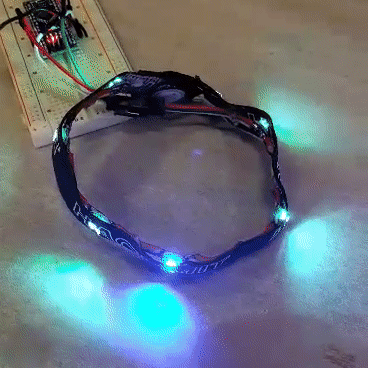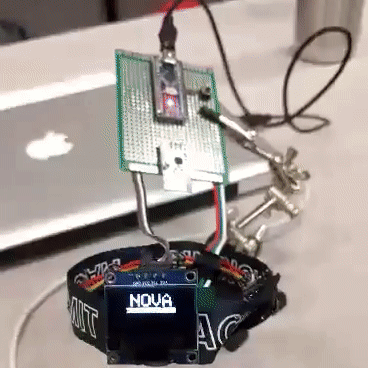HackMIT 2017 - Project Nova

This September, myself and three of my friends all joined forces and participated in HackMIT, a 24 hour hackathon where hackers (that's us) reinvent and create whatever we want.
Our team was comprised of two electrical and two mechanical engineers. Many of the projects we saw were software based, but we decided to go another route and create Nova.
Nova is a community based interactive storytelling experience. Each participant wears a wristband, called "stars", with LEDs, a small monitor, a speaker and a button. Users are given a color based identifier and a faction - red or blue which light up the LEDs with a brightness of 5. You can think of brightness as health or happiness, which you can gain and lose.

The startup screen
If your star goes out, it is re-spawned with the starting brightness of five, but the faction is now changed to the other team. The experience ends when all stars are of the same faction. Participants need to reconcile the desire to improve their own brightness and promote their faction with the knowledge that doing so aggressively will cause the entire game to end.
Part technical gadget, part artistic experience, we challenge our users to consider the purpose of their activities: by pushing for your personal or faction agenda, you can cause the whole game to shut down forever. By becoming the sole faction, have you "won the game"? Is this better than continuing to enjoy the experience Nova has brought to you along the way?

Two bracelets, able to 'talk' to each other through NRF24L01 wireless modules
As you approach other users, the stars interact with each other. If the star is a member of the same faction, each user gets +2 brightness in their LEDs. If the star is a member of the opposing faction there are two options. First, the users can agree to make peace. Both users will walk away with +1 brightness. If one or both of the users doesn't agree to make peace, then they go into a challenge. The challenge is displayed on each of their monitors. Some examples are rock paper scissors, staring contest, or the person who can say "hello" in the most languages. After the two users complete the challenge, the winner presses the button. The winner receives 2 brightness and the loser has 2 brightness removed. If both users were to press that they won, they would each lose 3 brightness as a dishonesty penalty.

The 'happiness' LED sequence accompanied with sound

The full startup sequence through first challenge (rock paper scissors)
Constructed Using:
Arduino Nano, NRF24L01 wireless modules, RGB LEDs, 8 Ohm Speakers, OLED LCD Display
My Contributions:
-
Initial concept brainstorming
-
Band Design and construction
-
LED soldering
-
Producing sound through speakers
Conclusion:
Our team was very happy with the final product of this Hackathon. Next, we want to continue to develop the personality of our stars by adding more emotional responses. In particular we would like to add an IMU so we can detect different hand motions and perhaps verify winners of challenges. In the future I would hope to be more helpful with coding and try to have our team prepare before hand so that our team might be able to get more sleep. We had a great time and thoroughly enjoyed creating a story for our project. It was great to see that it stood out in the judging process as well!
Prizes Awarded:
Best use of Storytelling
-
Description: sponsored by Disney
Master of Both Worlds
-
Description: Some hacks rock the software and other rock the hardware, but this prize goes to the project that masters both worlds. The hardware and software components of the winning project should both be substantial, technically challenging, and awesome on their own, and even better rolled in one project!

Team "Meet your Makers" - me on the right